#selim iii
Explore tagged Tumblr posts
Text





"Of the several ways in which Nurbanu's career broke tradition, her burial in the tomb of Selim II had perhaps the greatest symbolic import. [...] By linking his mother with his father in this manner, Murad emphasized his mother's place within the dynastic family and suggested that his legitimacy was derived from her as well as from his father." —The Imperial Harem, by Leslie Peirce
#magnificent century#ottoman history#nurbanu sultan#selim ii#murad iii#my caps#okay but seriously#Selim loved his son so much#that contemporaries were baffled#like he totally defied the expectations of the time to be a family man#I also view this move on his part as a true sign of just how much he loved nurbanu#since unlike with his father#there wasn't any motivating factor for him to marry his haseki#it really seems like he just did it because he wanted to esteem her as his partner
41 notes
·
View notes
Text
reallifesultanas Thank you very much for your answer! Yes I meant Dumas not Alderson sorry for that! Is there a reason for the illogical amount of salaries? I mean the earlier salary lists of registers clearly help us to indentify the sultanas. The 1555-1556 registers are 100% logical; the 1603-1604 registers are still logical: Safiye, Handan, aunts of Ahmed, great-aunt of Ahmed, great-great aunt's daughter (Ayse Hümasah), cousin of Mehmed III, far relatives. But then there is this one.. highest salary for the full sisters of the sultan is logical, but then what does the daughters of Murad III doing there? Fahri/Kamer and Hümaşah/Rukiye* are surely Murads and so Ümmügülsüm could be also Murad's... For the lesser salaries Beyhan, Safiye, Hatice I could imagine they were Mehmed III's, maybe Beyhan's Mustafa was Mirahur Mustafa? But these stipends are just not logical... (*Murad III's daughte Rukiye was said to be married to Nakkas Hasan not Huma). And for Ümmügülsüm there is that one report from 1688 (Katherine Trumbull) when it is said she developed a relationship with Sultana Ümmühan, the aunt of the deposed Sultan Mehmed IV, through visits to the harem. This Ümmühan could be Halil Pasha's wife and so Murad III's/Mehmed III's daugher, or is it more likely not an aunt but sister/cousin? Or she truly can be Ahmed I's daughter? There is this 85 numaralı Mühimme defteri that provide some informations suggesting suggesting Ümmügülsüm was sister of Murad IV. Sadly I dont have the book so I cannot check how true is this claim...
I hope you don't mind if we continue here on ottomanladies.
I know the harem register doesn’t seem to make sense from the point of view of hierarchy but we must remember that the hierarchy could be broken on the basis of favouritism. Maybe those aunts were more favoured than the others.

In this table we can see Gevherhan Sultan, a great-aunt of Ahmed I’s, the reigning sultan. Dumas mistakenly identifies her as a daughter of Murad III’s and a concubine of non-haseki rank, but the reality is she’s first because she’s the most senior princess alive. If you look closely at the second category — “Frais de bouche” — she receives the same amount as Ayse and Fatma, Safiye’s daughters. Gevherhan was quite favoured by Ahmed I because she had trained Handan in her household. Also, her late husband Cerrah Mehmed Pasha had performed Ahmed I’s circumcision. Borekçi says that she was the only recipient — apart from Handan and Safiye — of sable fur:
“A register preserved in the Topkapı Palace Archives gives further details of the gifts Gevherhan Sultan received from her great grand-cousin. At the beginning of this register, there are records of the furs and robes of honor sent by the new sultan to his larger family right after his enthronement on December 27, 1603. Here, Gevherhan Sultan is listed as a recipient of a sable robe (semmûr kaplu nimtâne) and recorded as the third female member of the dynasty after the retiring queen mother, Safiye Sultan, and the new queen mother, Handan Sultan, and before all other living sisters and daughters of Murad III and Mehmed III -- a clear indication of her privileged position. Later, on February 6, 1604, she again appears in the register, this time as the only female family member apart from Handan Sultan to receive a fur-trimmed silk robe.”
(I believe the 6 şehzâdegân are unmarried princesses that Ahmed still had to matchmake but this is another story)
I know it’s Rukiye that Öztuna says has married Nakkaş Hasan Pasha but he could be wrong tbh, it wouldn’t be the first time. Also, neither Sakaoğlu or Uluçay confirm this; they give no information about Rukiye except for the identity of her mother. Unfortunately Öztuna never gives his sources so we don’t know where he found that Rukiye was married to Nakkaş Hasan Pasha. I would trust the harem register and contemporary sources (the ragusian diplomat, in this case) more tbh… both say that Nakkaş Hasan Pasha was married to a princess called Hümaşah…
About Beyhan… the problem is the wife of Mirahur Mustafa Pasha went on to marry Cigalazade Sinan Pasha’s son Mahmud Bey in 1612, and died before 1620, the date of Mahmud Bey’s second wedding, which means she shouldn’t have been alive in 1638-39. The Ragusian letter date 1648, though, lists a Beyhan Sultan widow of “Nideli Mustafa Pasha”— unfortunately, I can’t say who this man is or what “nideli” means.
I do agree with you, though. I think that Beyhan, Safiye, and Hatice are daughters of Mehmed III. We know that seven princesses were married in the summer of 1613, after all. A letter dated July 1613 by a Ragusian diplomat, furthermore, says that “at the present there are fifteen sultanas”.
About Katherine Trumbull, I guess you mean this:
“While in Istanbul, Katherine had developed a relationship with Sultana Ümmühan, Mehmed IV’s aunt and sister to Ibrahim II. On 14 July 1688, Katherine met with Ümmühan for the first time, and the two women continued to meet in the imperial harem throughout Trumbull’s residence in Istanbul. During these visits, Katherine must have been accompanied by someone with knowledge of spoken Turkish, or else it is unclear how she would have been able to communicate with the women she met in the harem. At any rate, when she returned to the embassy, she brought to Trumbull news of things taking place in the Ottoman court.” — Ghobrial, John-Paul A, 'Overcoming Distance in Everyday Communication', The Whispers of Cities: Information Flows in Istanbul, London, and Paris in the Age of William Trumbull (Oxford, 2013; online edn, Oxford Academic, 23 Jan. 2014)
Unfortunately, William Trumbull’s diaries were not published, they’re in the British Library. I always like to cross-check my sources and the fact that I can’t read the original kind of annoys me. Ümmühan is quite an unusual name for an Ottoman princess: Ümmi means mother and Han sovereign, it kind of sounds like “valide sultan”, which is why I thought it was a title for a moment but I couldn’t find anything to confirm this. It is kind of interesting, though, that Öztuna says that Ibrahim’s eldest daughter was called Ümmügülsüm, who could have been named after another Ümmügülsüm (the one that in 1622 was unmarried? Who knows)
The Mühimme defteri is not a book but a collection of copies of all the imperial decrees or decisions taken in the imperial council. They’re numbered and the number 85 refers to the years 1630-31. You can find the PDF for free on the website of the Turkish National Archives but, well, it’s in Ottoman Turkish.

(This is one of them)
So I can’t really read it even though I have it.
#ask: ottoman history#reallifesultanas#gevherhan sultan daughter of selim ii#rukiye sultan daughter of murad iii#humasah sultan daughter of murad iii#unnamed daughters of mehmed iii#i'm sorry if the layout looks weird but it's been so long since i used tumblr and i'm a little rusty
12 notes
·
View notes
Text
magnificent century ep 139: "and after unjustly and underhandedly killing his noble and valiant brother bayezid, the unworthy selim ascended the throne of the ottoman empire"
magnificent century kösem ep 1: "in his childhood ahmed was deeply traumatized as he witnessed his father mehmed carry out the four-hundred-year-long precedent of legal fratricide and execute all nineteen of his brothers upon his ascension to the throne of the ottoman empire"
#seriously writers. make it make sense writers.#selim#selim ii#ahmed i#mehmed iii#sehzade bayezid#bayezid#muhteşem yüzyıl#muhtesem yuzyil#muhtesem yuzil kosem#magnificent century#magnificent century: kösem#muhteşem yüzyıl: kösem#mc tag#i ramble
14 notes
·
View notes
Text
I think I should do a gif set of Murad telling Selim he knows what his father did to survive and he won't make the same mistakes and then the scene from Kösem about the many little coffins that left the palace on the day of his son suceeding to the throne.
8 notes
·
View notes
Text

“I associate King Abdullah II of Jordan with Selim II (Sultan of the Ottoman Empire) and his wife Nurbanu Sultan with Queen Rania of Jordan, I think they are as similar as possible, especially the way they came to power, and I consider Crown Prince Hussein similar to Sultan Murad III (son of Selim II) and Rajwa similar to Safiye Sultan (Nurbanu daughter-in-law and Murad wife).” - Submitted by Anonymous
#King Abdullah II#Queen Rania#crown prince hussein#princess rajwa#murad iii#selim ii#nurbanu sultan#safiye sultan
17 notes
·
View notes
Text
Lets talk about Ümmügülsüm Sultan
There is a chance, that Kösem and Ahmed had another daughter together: Ümmügülsüm.
I am so glad, that with Anonymous sender and Ottomanladies, the truth came to light. Ottomanladies answered very long and very detailed about Ümmügülsüm, she shared her thoughts about the topic, now, here, you can find a conclusion from me:
What we know:
A privy purse register from 1622 gives the names of five unmarried princesses, who may be daughters of Ahmed, Osman II, and even Mehmed III: Umm-i Külsum(=Ümmügülsüm), Hanzade, Halime, Fatma, and Akile. Hanzade and Fatma were Kösem's daughters; Akile is possibly mistaken for Atike or Abide; Halime might be Mehmed III's daughter, named after her mother, Halime. But Ümmügülsüm was less clear.
The relazione of Angelo Alessandri from 1637 says that Murad IV had four FULL-sisters. We know three of them: Ayse, Fatma, and Hanzade. But who could be the fourth? Gevherhan was already dead, Atike was well-knownly not a full-sister and also not Abide. Maybe Ümmügülsüm?
There are some decisions and letters of Murad IV, where he mentions Ümmügülsüm as a sister of his. He uses the same wording that he used for Ayse, who undoubtedly was his full-sister, suggesting Ümmügülsüm was also a full-sister of his.
The 1638/39 harem registers mention one Ümmügülsüm Sultan who received the highest payments besides the three already known daughters of Kösem (Ayse, Fatma, Hanzade) and two daughters of Murad III. This means she could be either the daughter of Murad III or Ahmed I. But since Ahmed I's other daughter, Atike - who was not Kösem's - got a lesser stipend, if Ümmügülsüm is Ahmed I's daughter, she had to be Kösem's daughter too and so she is the fourth full-sister of Sultan Murad IV.
In 1648 the Raguzan envoy also mentions her (possibly her as they use the name Iumi), as the wife of Ahmed Pasha, governor of Herzegovina. They probably married ~1642 until the pasha's death in 1648. This was her second marriage, her first husband was one Halil Pasha, with whom she married before 1638.
In book ''Whisper of the cities'' one Ümmühan Sultan is mentioned as she met with the English ambassador's wife. Based on her, Ümmühan was said to be the aunt of deposed Mehmed IV and sister of Ibrahim I. This happened in 1690, so she still was alive then.
There are still questions:
Why no historian ever discovered this information as none of the evidence is new?
Why Ümmi is not mentioned among Ahmed I's children?
Where is she buried? *
When was she born? *
Why Ibrahim did not force her to serve Telli Hümasah (his wife) when he did it to all of the other daughters of Kösem?
To be honest the burial place of Ahmed I is quite a mess. For example there are two sarcofagies for 'Zeynep' daughters of Ahmed I. One of the sarcofagies stands for an adult woman. There was no daughter of Ahmed, called Zeynep who reached adulthood. So maybe the name is mistaken and that Ümmügülsüm. Maybe she was buried somewhere else as she lived a quite long life, survivin everyone around her and her grave is not idetified yet.
Considering the known children of Kösem and their birth date, the most possible for Ümmügülsüm is that she was born during the late reign of Ahmed I. In 1605 Kösem gave birth to Mehmed; in 1606 or 1607 to Ayse; then in 1607 or 1608 to Fatma; in 1609 to Hanzade. While I see that there is a gap here for one more child (if Kösem got pregnant extremely rapidly), she cannot be older than Fatma, as she was also not married off in 1622 yet, and also since we know quite precisely the sequence of these daughters, I do not think another one was born here but no one knows about her. It would be strange. Then in 1612, she gave birth to Murad, but between him and Hanzade there was time for another child - let it be Selim who was born in 1611 or Ümmügülsüm. Then Kasim followed Murad quite quickly, he was born in 1614, and then Ibrahim came in 1615, so there was no time for anyone else between Murad and Ibrahim. After 1615 there is another chance for the birth of Ümmügülsüm. So she either was born after Hanzade (~1611), or after Ibrahim (~1616). Either way - considering she was not just still alive in 1690, but was surely not suffering, dying since she was involved in the diplomacy meeting - she possibly died in the 1690s, she very probably reached 80 maybe even more in the end.
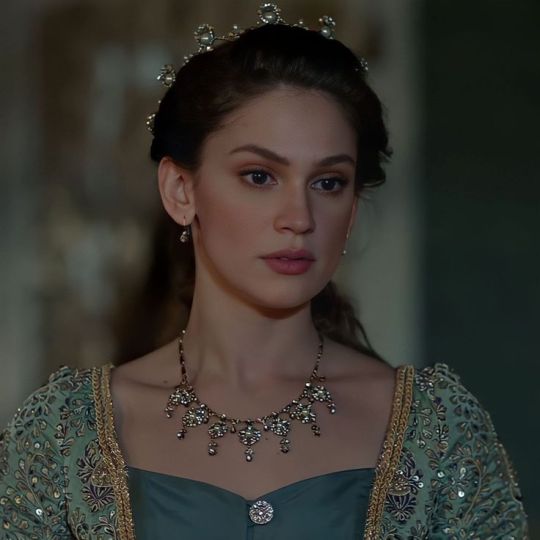
#ottoman history#ottoman empire#valide kösem sultan#mahpeyker kösem sultan#kösem#ahmed i#ümmügülsüm#ümmügülsüm sultan#ümmi#ummuhan#ummugulsum#ümmihan#ummukulsum#ümmükülsüm
24 notes
·
View notes
Text







Royal Deaths, 22nd September.
1093 - Olaf III, King of Norway.
1408 - Johannes VII Palaeologus, Byzantine Emperor
1520 - Selim I, the Grim, Sultan of the Ottoman Empire.
1531 - Louise of Savoy, mother and regent for King Francis I, dies of the plague at 55.
1828 - Shaka, South African Zulu king, founder of the Zulu nation, murdered.
1840 - Princess Augusta Sophia of the United Kingdom, daughter of King George III and Queen Charlotte.
1948 - Prince Adalbert of Prussia, son of Wilhelm II, German Emperor and King of Prussia.
11 notes
·
View notes
Text

As folk may know, Selim is actually a distant descendent of Kindred Elder, Galeb Bazory, previously known as Şehzade Süleyman and refers to him as his 'uncle' just as Galeb refers to Selim as his 'nephew'. But a big part of the reason for Galeb's very discreet fondness for Selim despite them being natural enemies is actually because he reminds him of his late brother, Mustafa III, both in personality as well as appearance as they share similar facial features and hair colour. As much as it hurts Galeb to see his late brother's likeness and be reminded of the life he eternally longs for it does also bring him a certain amount of comfort as if reigniting a part of him that he'd buried away for over three centuries now. It's both pleasant and terrifying to him to realise that a part of Süleyman still exists inside him and that he finds himself protective of Selim just as he had been with his younger brother, Mustafa, until he was forced to flee Constantinople, never seeing any of his family again. Until now.
9 notes
·
View notes
Text


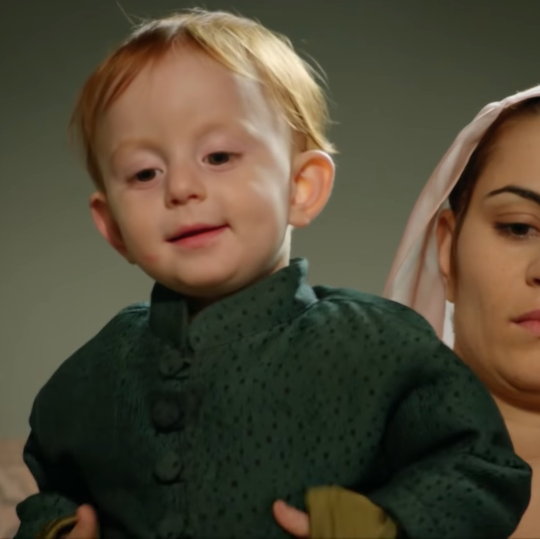




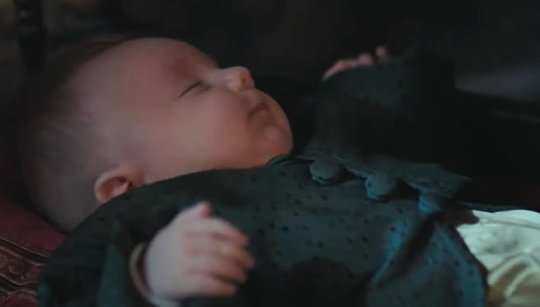
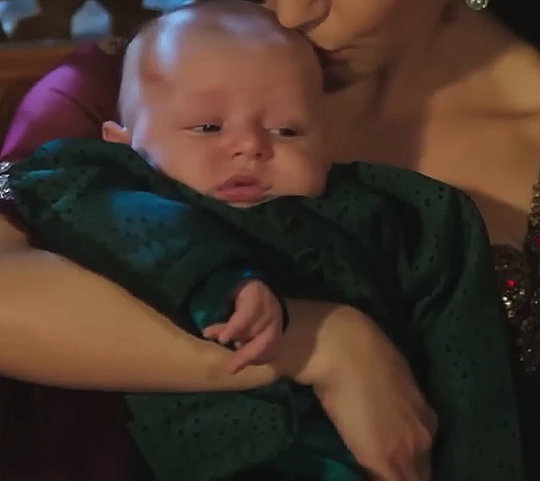
This green shirt with black dots was first worn by Şehzade Mehmed in the tenth episode of the first season of Magnificent Century. It was used again three times in the second season, first on Şehzade Bayezid in the fourteenth episode, then on Şehzade Selim (later Sultan Selim II) in the eighteenth episode and lastly on Şehzade Cihangir in the the twenty-ninth episode. The shirt was also worn twice in the fourth season by Şehzade Murad (later Sultan Murad III) and Şehzade Bayezid's son Mehmed in the eleventh and thirty-fourth episode, respectively.
Magnificent Century: Kösem used the shirt three times during its first season on Şehzade Osman (later Sultan Osman II), Şehzade Mehmed and Şehzade Ibrahim (later Sultan Ibrahim) in the fifteenth, twentieth and twenty-first episodes.
#Muhteşem Yüzyıl#Muhteşem Yüzyıl: Kösem#Magnificent Century#Magnificent Century Kösem#Magnificent Century Kosem#period drama#costume drama#historical drama#Şehzade Mehmed#Sehzade Mehmed#Şehzade Mehmed (Son of Hürrem)#Şehzade Bayezid#Sehzade Bayezid#Şehzade Bayezid (Son of Hürrem)#Şehzade Selim#Sehzade Selim#Selim II#Şehzade Selim (Son of Hürrem)#Şehzade Murad#Sehzade Murad#Şehzade Murad (Son of Nurbanu)#Murad III#Şehzade Mehmed (Son of Şehzade Bayezid)#Şehzade Osman#Sehzade Osman#Osman II#Şehzade Osman (Son of Mahfiruze)#Şehzade Mehmed (Son of Kösem)#Şehzade Ibrahim#Sehzade Ibrahim
18 notes
·
View notes
Text
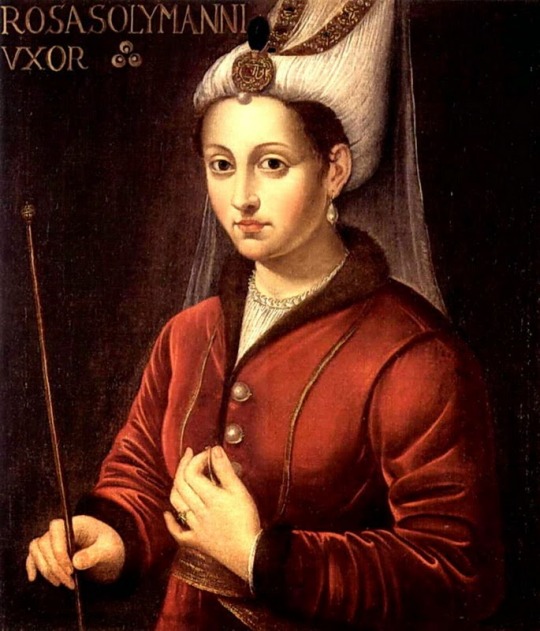

The other day I played the “Living People Related to Maria Theresa” game after a while, and remembered I once did that with Hurrem Sultan and thought I'd try it again, so here goes!
This is Roksan Kunter Özkan, she is a Turkish TV presenter, sports reporter, and media personality, and descends from Hurrem through her son Selim II. Supposedly her first name is derived from Roxelana, one of the names Hurrem was known by.
Roksan Kunter Özkan (Born August 10th, 1984) –> Ayten Sofia Nami Osmanoğlu –> Sultanzade Osman Nami Bey –> Ayşe Sultan –> Abdul Hamid II –> Abdulmejid I –> Mahmud II –> Abdul Hamid I –> Ahmed III –> Mehmed IV –> Ibrahim –> Ahmed I –> Mehmed III –> Murad III –> Selim II–> Hurrem Sultan
14 notes
·
View notes
Text





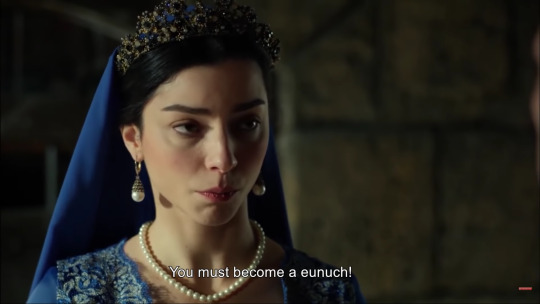
"According to the same sources, Gazanfer became first kapı ağası and, after his brother’s death, also has odabaşı. In this way he became one of the most powerful persons in the Ottoman Empire; he held his office for more than thirty years, under the eign of Selim II, Murad III and Mehmed III. He was also a patron of artists and writers such as the historian Mustafa Ali."— Maria Pia Pedani, Safiye’s Household and Venetian Diplomacy
#magnificent century#ottoman history#gazanfer agha#my caps#that the show once again#has to blame a woman for his fate#alongside of trying to make him interested in nurbanu at all#considering the not great biases towards eunuchs at the time#is all a little#sigh worthy to say the least
15 notes
·
View notes
Note
Excuse me, but I also think that Murad and Safiye did not have a daughter named Mihrimah.
The problem of your work as a historian is that you only pay attention to the writings of the ambassadors and ignore the documents of the harem.
In Mustafa Altun's book, (Yüzyıl Dönümünde Bir Valide Sultan: Safiye Sultan'ın Hayatı ve Eserleri) the rights of women in the sultan's court are specified in the final pages of the book. It is mentioned how much Sultan's sisters and cousins received. Even the names of the Sultan's four children, Mehmed, Mahmud, Ayşe and Fatma, are mentioned, but there is no name of another child.
It is more interesting that this information covers up to 1582. If Safiye had another child, most likely they would have died in infancy. If she was an older girl, her name would definitely be mentioned in the list of harem women. If Safiye had another daughter, Ahmad would have named her on one of his daughters, as he did with the others.
The previously mentioned ambassadors each say the opposite. One says that the Sultan has one daughter, while the other says that the Sultan has two daughters. It is clear that not all ambassadors could have correct information about the Sultan's family.
I think the problem of my work as a historian is that you guys ask about stuff that actual historians find in a lifetime while I have to answer in a couple of weeks. Also, I don’t have harem registers at hand and I cannot fly to Istanbul to look at them. In short, I’m doing my best with the sources I have on my pc.
I have my problems with those harem registers because while I appreciate them for showing us that Bayezid’s daughter Hatice went back to the harem at some point in her life (probably after a marriage), I don’t see Mihrimah (Süleyman and Hürrem’s daughter), who was alive in 1576:

In the top part there’s Murad III’s immediate family, so Safiye and his sons (Ayse and Fatma weren’t born yet). In the middle part we have expenses for clothes, but in the bottom part we have those who ate at the imperial kitchen and it seems strange to me that Mihrimah is not included. Also, where is Fatma binti Selim II? She was alive at the time.
Ironically, Fatma reappears after her supposed death (1580) in harem registers dated 1581-82. Either this is a mistake by the harem clerk or she didn't die in 1580 after all.

On the other hand Şah has disappeared because she truly died in 1580, it seems.
It it interesting that a historian like Uluçay missed these harem registers where Fatma is considered alive in 1581-82.
On the other hand, maybe these harem registers are not complete. Or they’re wrong.
In any case, a Mihrimah Sultan binti Murad III definitely existed, and maybe Mehmed Sureyya was wrong when he said that she was the eldest when Murad died. Or maybe we were wrong and she was the eldest when she died, therefore moving her date of birth forward.
EDIT: Fatma Sultan binti Selim II died on 24 June 1590, according to Seyyid Lokmân, Mustafa Selaniki, and İsmail Hâmi Danişmend (Lokmân and Selaniki were contemporaries). Mehmed Süreyya's Şaban 988 instead of Şaban 998 seems just an oversight. Thanks to @rhaenahanzades and @kehribar-sultan for pointing it out.
12 notes
·
View notes
Note
Who are you? 👀
*taps her cane on the ground* Madame Ayanisefa, second wife and consort of Sultan Selim III, politician, opera singer, toxicologist—and now, a business owner.
2 notes
·
View notes
Text

~Halime Sultan~
Her exact date of birth is unknwon. Most historian agree that she was a woman of abkhazian origin.She gave birth to at least four childern to Sultan Mehmed III. Her first and last child have a age differnce of 15 years what suggest that she was clearly the favorite consort. After the death of princes Süleyman and Selim, sons of Handan Sultan, Halime's son Mahmud was the eldest living son. But Mehmed III never named him as his heir. In fact, he saw him as a threat because Mahmud was popular among soliders. Mahmud often spoke against his grandmother, Valide Safiye Sultan. Once, Halime wrote a letter to a seer and asked if her son would ascend the throne, the reply letter came and the seer wrote, that Mahmud would ascend the Throne within 6 months after unpleasant thing happend to Mehmed III. The reply letter unfortunately never reached Halime but her mother in law, Safiye. Mehmed III executed his son Mahmud and Halime was exiled to Old Palace. In fact, it was belived for centuries that Halime was executed along with her son. After Sultan Mehmed's death, Ahmed I ascended the throne. He didn't execute Halime's youngest son Mustafa and thus stopped the fratricide law. But he created cages , appartments where the survived princes lived without right of proper education and right of having harem. After Ahmed's death, Halime's son Mustafa acended the throne. But his reign didn't last long because after all this years spent in kafes, he suffered of mental problems. Mustafa was dethroned and locked up again and Ahmed's son, Osman ascended the Throne. Four years later, Osman was deposed and Mustafa ascended the throne again. Halime worked hard to built alliances and urged to appoint her son in law, Davut Pasha as grand Vezir. Halime and Davut ruled the Empire. Davut Pasha was found guilty of execution of Sultan Osman 2 and was executed in 1623. Halime wothout Davut's help couldn't rule the empire. She made a deal with Kösem Sultan, that Mustafa is going back to kafes and Kösem's son Murad would ascend the throne. Halime moved back to Old Palace. She lived there forgotten. It is unknown when she died but since she is buried in Mustafa's türbe in Hagia Sofia. This suggest that she died after Mustafa who died in 1639.
youtube
13 notes
·
View notes
Text

Konstantin Kapıdağlı (Konstandinos Kizikinos) (late 18th century-first quarter of the 19th century): Portrait of Sultan Selim III,1803 Topkapi Palace Museum, Istanbul/Turkiye
4 notes
·
View notes
Text
I'Una de las dos enormes urnas de mármol para las "lustration" (ritual de purificación) que se trajeron a la Basílica de Santa Sofía (ahora Mezquita) desde Pérgamo durante el reinado del sultán otomano Murad III. Datan del período helenístico y se tallaron desde bloques individuales de mármol en el siglo II adC.
Estambul, Turquía.
Más sobre Murad III:
"Murad III fue uno de los hijos del sultán Selim II y Afife Nurbanu, quien fue originaria de la República de Venecia y quien asesoró a su hijo durante su sultanato. La pareja se casó y tuvo cuatro hijos aparte de Murad III. Selim II tuvo otros nueve hijos con diferentes parejas, aunque el número es inconcluso para los historiadores. De todos ellos, los varones fueron mandados a ejecutar cuando Murad ascendió al trono. Una orden que se cumplió el 22 de diciembre de 1574. El sultán tuvo varias esposas, aunque su favorita siempre fue Safiye, quien se convirtió posteriormente en Madre Sultana. Se dice que tuvo más de 20 hijos varones y un número similar de hijas. Su hijo Mehmed fue quien ocupó el trono cuando Murad III murió. Al igual que su padre, Mehmed mandó a ejecutar a la mayoría de sus hermanos para evitar problemas en la sucesión como sultán del Imperio otomano."

One of two huge marble lustration (ritual purification) urns that were brought to the Hagia Sophia from Pergamon during the reign of the Ottoman Sultan Murad III. They are from the Hellenistic period and were carved from single blocks of marble in the 2nd century BCE. Istanbul, Turkey
More: https://thetravelbible.com/museum-of-artifacts/
893 notes
·
View notes